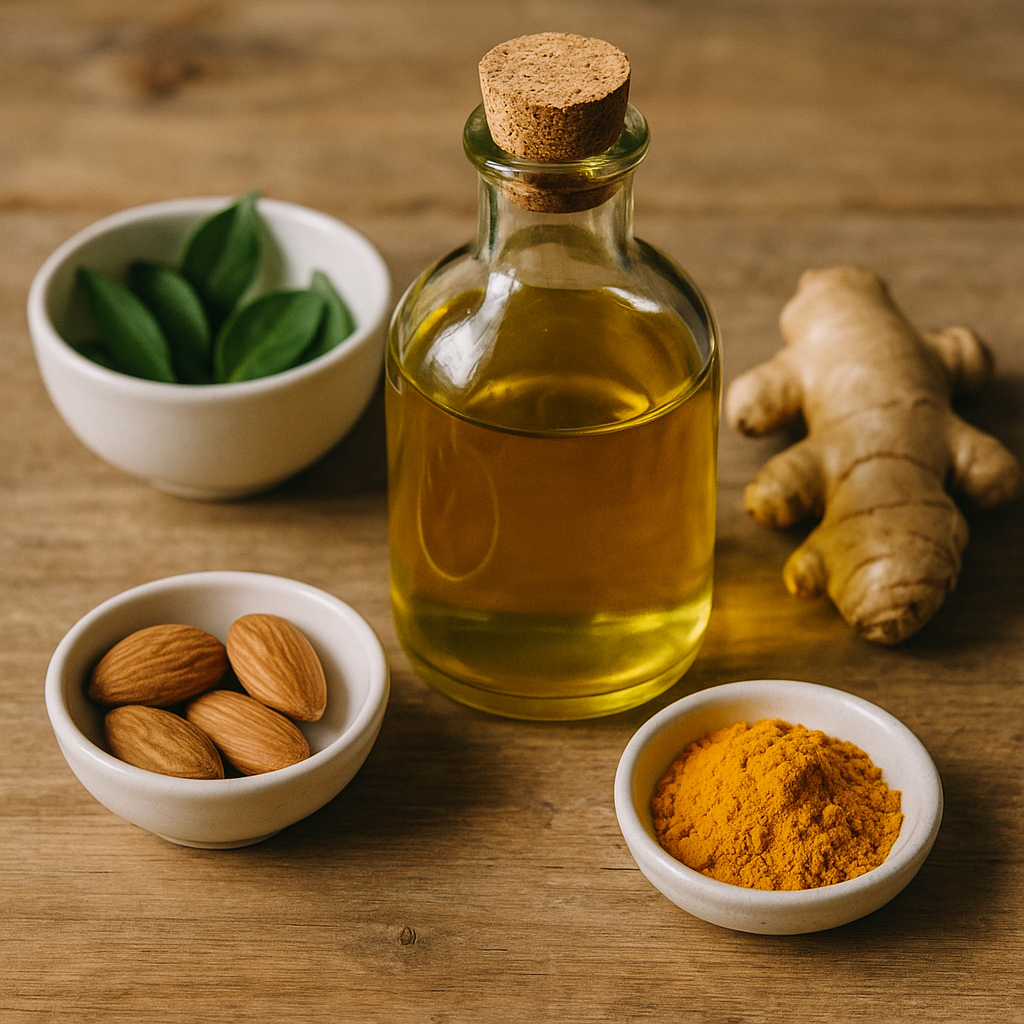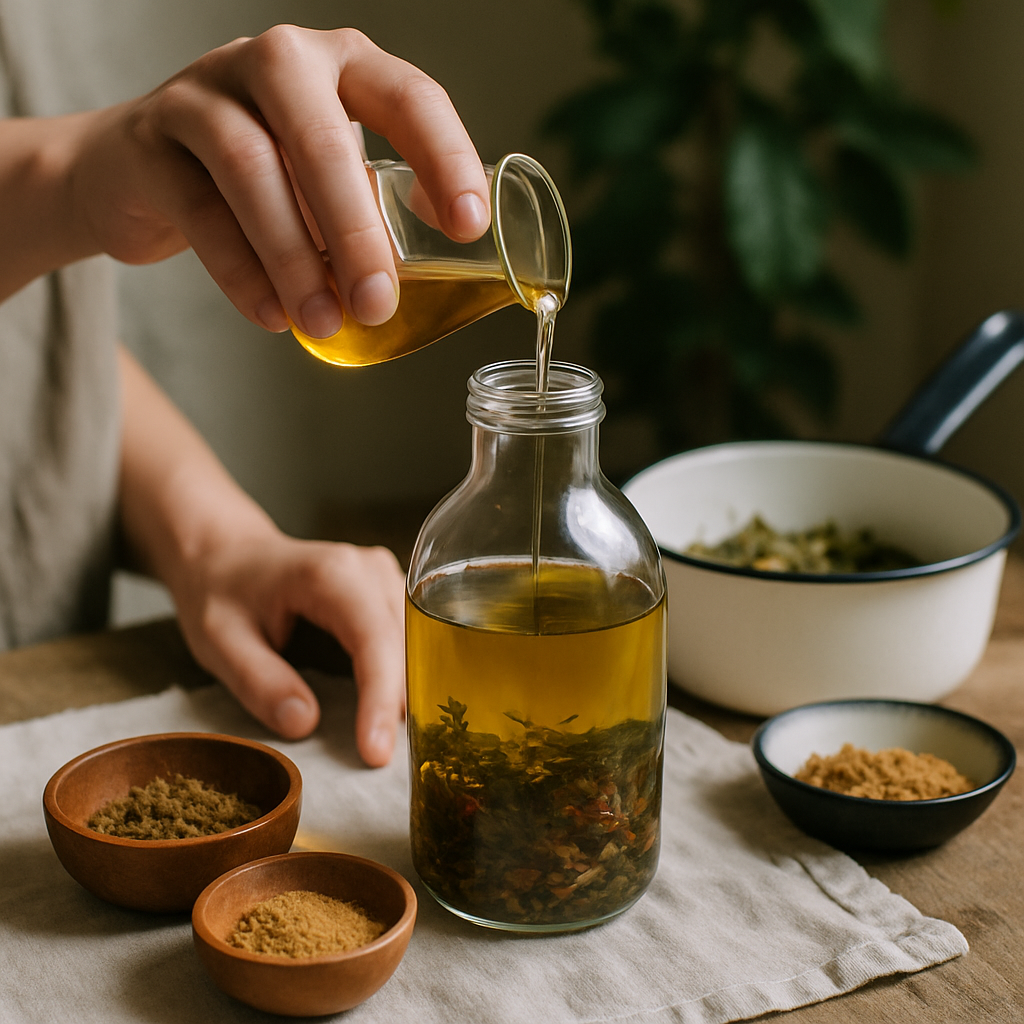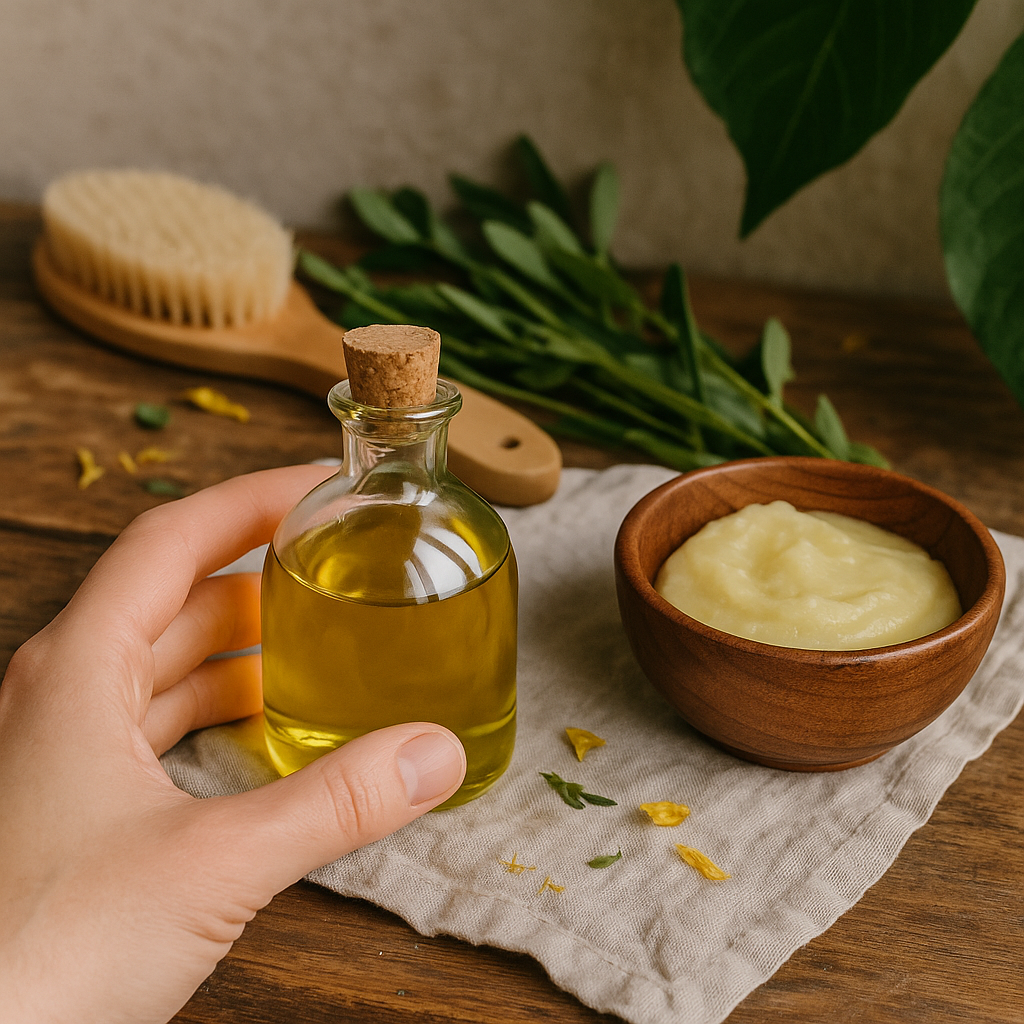Ask Ayurvedic doctor a question and get a consultation online on the problem of your concern in a free or paid mode. More than 2,000 experienced doctors work and wait for your questions on our site and help users to solve their health problems every day.
Shop Now in Our Store
How to Make Abhyanga Oil at Home: Ayurvedic Massage Guide

If you've ever wondered how to make abhyanga oil at home or questioned what ingredients actually go into a high-quality ayurvedic massage oil, you're not alone. With the rise of holistic self-care and the revival of ancient wellness traditions, more people are rediscovering the powerful benefits of abhyanga — a deeply nourishing, daily oil massage rooted in Ayurveda. This guide is your practical go-to for making and using abhyanga oil at home, complete with a recipe, tips, and the science-backed advantages of incorporating this practice into your routine.
We'll dive into abhyanga oil benefits, its traditional roots, and the best abhyanga oil ingredients to match your dosha type. Whether you're new to Ayurveda or already smearing sesame oil on your body like a pro, this article will help you elevate your self-care game and feel more grounded, inside and out.
What Is Abhyanga and Why It’s Important in Ayurveda
Meaning and Role of Abhyanga in Daily Routine
Abhyanga (pronounced uhb-yung-uh) isn’t just a fancy term for a massage. In Ayurveda, it's considered a core part of dinacharya, or daily routine — almost as essential as brushing your teeth. This therapeutic practice involves massaging warm, herb-infused oil all over the body. The goal? To balance the doshas (Vata, Pitta, and Kapha), promote circulation, calm the nervous system, and keep skin youthful and vibrant.
In fact, some ancient Ayurvedic texts suggest doing abhyanga daily. Not just when you're stressed or sore, but every single morning before your shower. It's not always realistic (let’s be honest), but even doing it 2-3 times a week can make a big difference.
Abhyanga Oil Benefits for Body, Mind, and Skin
You might be wondering: why go through the effort of learning how to make ayurvedic massage oil at home when you can buy something off the shelf? The answer’s in the benefits. Homemade oil is personalized, free from synthetic chemicals, and tailored to your specific dosha.
Here are a few standout abhyanga oil benefits:
-
Boosts circulation and helps detoxify the lymphatic system.
-
Calms anxiety and promotes better sleep.
-
Moisturizes dry skin, reduces flakiness, and slows signs of aging.
-
Supports muscle recovery and reduces fatigue or stiffness.
And on a deeper level? Regular abhyanga can help bring a sense of presence and calm into your everyday life. It's not just body care — it's soul care. (Cheesy? Maybe. But it’s true.)

What Oil to Use for Abhyanga by Dosha Type
So, you’re on board with the practice. Now you're probably asking: what oil to use for abhyanga?
Different doshas require different oils to stay balanced. Here’s a super basic guide:
-
Vata (air + space): Use warm, heavy oils like sesame or almond. They’re grounding and warming, perfect for dry or anxious folks.
-
Pitta (fire + water): Cooling oils such as coconut or sunflower are ideal. They soothe inflammation and heat in the body.
-
Kapha (earth + water): Lighter oils like mustard or flaxseed stimulate circulation and prevent stagnation.
Feeling ambitious? You can mix oils to suit your dual-dosha constitution. A little trial-and-error goes a long way here — don’t stress about perfection.
Common Herbs and Ingredients in Abhyanga Oil
When creating your abhyanga oil recipe, consider these Ayurvedic herbs to level up the healing power:
-
Ashwagandha – rejuvenates and strengthens muscles.
-
Brahmi – calms the mind, great for mental clarity.
-
Turmeric – anti-inflammatory, ideal for skin.
-
Neem – antifungal and antibacterial.
-
Manjistha – supports lymphatic detox and brightens the skin.
You can either add these in powdered form during the oil-prep stage or get them as herbal extracts. Just make sure to strain properly afterward — gritty oil isn’t the vibe.
Safety Tips for Sensitive or Allergic Skin
Before you dive into your DIY adventure, a quick but important note: test the oil on a small patch of skin first. Just because it’s natural doesn’t mean it’s irritation-free. Everyone’s skin is different. Especially when using strong herbs or essential oils, sensitivity can pop up unexpectedly. Also, if you're using homemade abhyanga oil on children or during pregnancy, it's always best to consult with a trained Ayurvedic practitioner.

How to Make Abhyanga Oil at Home
So now that you’re ready to make your own Ayurvedic massage oil, let’s walk through the process. Making abhyanga oil at home might sound complicated at first, but it’s surprisingly simple once you get the hang of it. Plus, the smell of warm herbs and oils filling your kitchen? Kind of magical. Way better than most store-bought stuff, to be honest.
Abhyanga Oil Recipe: Ingredients and Quantities
Here’s a basic abhyanga oil recipe that you can customize based on your dosha or what you have on hand. These quantities make about 200ml of oil, which should last 2–3 weeks with regular use.
Base Oil (choose based on your dosha):
-
100ml Sesame oil (good for Vata)
-
or 100ml Coconut oil (good for Pitta)
-
or 100ml Mustard oil (good for Kapha)
Herbs (use any combo of these, or others depending on your needs):
-
1 tsp Ashwagandha powder
-
1 tsp Turmeric powder (careful—it stains!)
-
1 tsp Manjistha powder
-
1/2 tsp Neem powder (optional, it has a strong scent)
-
1 tsp Brahmi powder
Optional:
-
A few drops of essential oils like lavender or frankincense for aroma
-
Vitamin E oil for skin nourishment
These are commonly used abhyanga oil ingredients, but feel free to experiment. Ayurveda is big on personalization, so trust your instincts. Just avoid dumping in everything at once — too many strong herbs can make the oil harsh.
Step-by-Step Instructions for Preparing the Oil
Alright, let’s make your oil. Grab a saucepan, a sieve or muslin cloth, and a clean glass bottle or jar for storage.
-
Warm the base oil over low heat. Don’t boil it — you just want it gently heated.
-
Add your chosen herbs and stir. Keep the heat low and let the mixture simmer for about 30–40 minutes. Stir occasionally.
-
If you see bubbling or any weird smell, reduce the heat. You’re aiming for slow infusion, not deep frying your herbs. (Been there... not ideal.)
-
Once the oil turns darker and aromatic, remove it from the heat and let it cool slightly.
-
Strain it through a cheesecloth or fine strainer into a clean bowl or directly into your storage jar.
-
Add any essential oils or vitamin E if you like, then seal the jar and label it with the date.
That’s it — your DIY abhyanga oil is ready!
Store it in a cool, dry place away from sunlight. It should stay good for a month or two. If it starts smelling off or weirdly sticky, it’s time to toss it and make a new batch.

How to Use Abhyanga Oil for Massage
Knowing how to use abhyanga oil is just as important as making it. The technique and timing can seriously affect how effective the whole thing is — and how relaxed you feel afterward.
Daily Routine and Timing for Best Results
Traditionally, abhyanga is done in the morning before your shower. It’s meant to wake up the body, stimulate the lymph system, and prepare you mentally for the day.
But honestly? Life’s hectic. If your only window is a nighttime wind-down, that’s still way better than not doing it at all. Just don’t apply it right before bed unless you plan to rinse it off — otherwise, your sheets are going to be, uh… permanently moisturized.
Application Method: Head to Toe
Start with a small amount of warm oil (you can heat it in a double boiler or just rub it between your hands).
-
Scalp first — massage in circular motions.
-
Face and ears — gentle strokes, avoid getting oil in your eyes.
-
Neck and shoulders — use upward and outward strokes.
-
Arms and legs — long strokes along the limbs, circular over joints.
-
Abdomen and chest — clockwise circles over the belly; gentle strokes on the chest.
Massage for at least 10–15 minutes, longer if you’ve got the time. The more regular the routine, the more you’ll notice the benefits.
How Long to Keep the Oil Before Bathing
After the massage, let the oil sit for 15–30 minutes. Use that time to meditate, do breathwork, or even just chill with a book or podcast. Let the oil soak in and work its magic. Then shower using mild soap — or if you’re hardcore, just warm water to retain more of the oil's moisture.
Conclusion
Creating and using your own abhyanga oil at home isn't just about following some old Ayurvedic tradition — it's about reclaiming slow, intentional care in a world that constantly rushes us. Whether you’re drawn in by the physical perks (smoother skin, better sleep, relaxed muscles) or the deeper emotional grounding, abhyanga oil benefits are far-reaching.
When you take the time to learn how to make ayurvedic massage oil at home, you not only avoid unnecessary chemicals found in commercial products, but you also create something entirely unique to you. Your body, your dosha, your healing.
To recap real quick:
-
Choose your abhyanga oil ingredients based on your dosha and specific needs.
-
Use a base oil (like sesame, coconut, or mustard), simmer with herbs, and strain well.
-
Apply warm oil from head to toe, wait 15–30 minutes, then rinse with a warm shower.
-
Make it a regular part of your routine — even just twice a week can make a difference.
Oh, and don’t forget — your first batch might not be perfect. The herbs might clump, or you might forget to strain it properly (been there, done that). No big deal. You’ll get better at it, and your body will thank you for even trying.
Give it a shot, share your experience, and maybe even invite a friend to join you in the practice. This isn’t just about skincare — it’s self-connection.
FAQs
How often should I do abhyanga with homemade oil?
Ideally, daily — especially in the morning. But realistically? Start with 2 to 3 times a week and see how your body responds. If you're dealing with stress, insomnia, or dryness, doing it more often can really help.
Can abhyanga oil be used for head massage?
Absolutely, yes. In fact, Ayurvedic head massage (shiro abhyanga) is incredibly beneficial. Just remember to use a smaller amount (so you don’t end up drenched), and let it soak in for at least 20 minutes before washing. Sesame or Brahmi-infused oils are great choices for calming the mind.
How long can I store homemade abhyanga oil?
If stored in a clean, airtight glass jar away from direct sunlight and moisture, your homemade abhyanga massage oil should last around 4 to 6 weeks. Adding vitamin E oil or essential oils with natural preservative qualities (like tea tree or lavender) can extend shelf life a bit longer.
If the oil smells funky, changes texture, or looks cloudy — toss it and whip up a fresh batch.
Final Thoughts
If you’ve made it this far, you now know not only how to make abhyanga oil at home, but how to personalize it, use it effectively, and make it a legit part of your self-care routine. The beauty of this practice isn’t in getting it perfect — it’s in doing it at all.
So why not try it today? Set aside 30 minutes this week, gather your abhyanga oil ingredients, and give yourself the kind of care that doesn’t come in a rush. Trust me, your nervous system will thank you.
This article is checked by the current qualified Dr Sujal Patil and can be considered a reliable source of information for users of the site.

